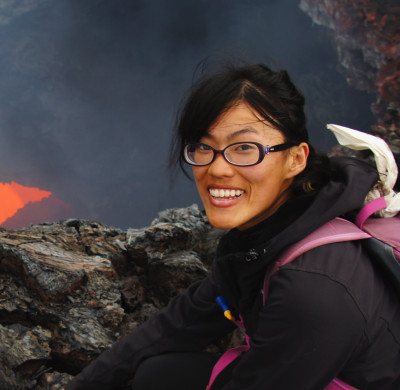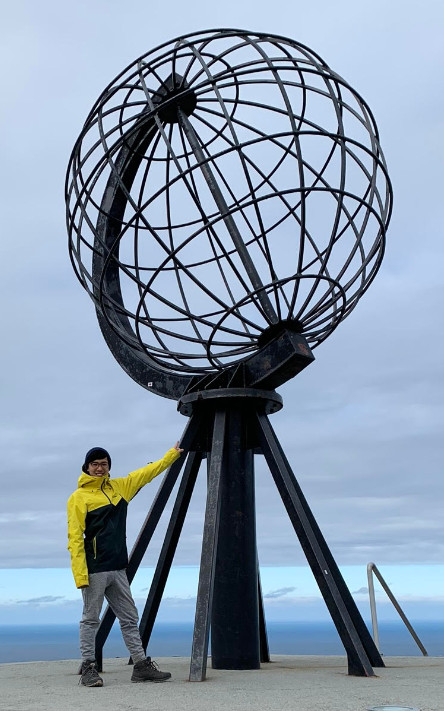The FEniCS Project has always adopted the philosophy of open source development. It is important to us that anyone may access and contribute. The community surrounding the FEniCS Project hosts a wide variety of users: academics, scientists, engineers, hobbyists, students and many more. We encourage anyone and everyone to take part, for example: in the Discourse group, on our Slack channel, contributing to the source code or joining us at one of the conferences.
The distinctiveness of all our backgrounds, combined with our individual ambitions, drives innovation in the FEniCS Project. Drawing from this inspiration, here we meet some of the members of the eclectic FEniCS community.
Kristin L. Schaefer, P.E. 🇺🇸

I grew up mostly in Texas, but my father worked in the oil industry, so we also lived in Indonesia and England, plus a semester of my undergraduate engineering program I studied in Mexico. Mechanical Engineering, especially design, is my first career, and I am licensed to practice in Texas. I am also certified to teach Engineering in Texas public schools. Now I have returned to school for my PhD in order to equip the next generation of engineers to solve 21st century problems by teaching at the university level.
For part of my dissertation, I will need to solve partial differential equation problems with finite-element methods for the design of theoretical materials, and this led me to FEniCS. I have used various technologies and programs as tools for my entire professional life, so this has been a fun challenge to learn FEniCS, Python, and Linux all at the same time! I appreciate how FEniCS allows a math-based “front-end” for problem set-up, and it just takes care of the rest of the solution, so that you can move your project ahead with the results (let’s call this the Engineering approach). Yet, if you need more than what is available, it is flexible enough to allow “back-end” improvements and modifications to develop new methods, modules, functions, and code so that FEniCS becomes more useful for everyone (let’s call this the Research approach).
My major interests in the discourse are Documentation, Tutorial files, and Installation, adding the “why”-type comments that a good teacher naturally wants to provide. I look forward to finding more uses for FEniCS and to furthering the discourse to help anyone interested in Engineering or Research approaches with this Finite Element Computational Software (the “ni” nicely transforms what could have been another boring acronym into a phonetic spelling for the mascot of the originator’s university… a bonus for pun-loving geeks like me!).
Tim D. Jones 🇦🇺

I had no idea what I wanted to be in my youth. And I don’t think I can give an honest account of how I got here. At some point I just realised that a lot of the things I was interested in had deep explanations rooted in physics. When I got to university I decided to try some things that would be new to me, including Psychology—big mistake. I became interested in Earth Science, but even then I was drawn to the sub-field of Earth Science that most resembles physics.
Now I’m what’s called a “computational geodynamicist”. More importantly, I am trying to solve the puzzle of how our planet got to its present state. And over the past 2 years I’ve been using FEniCS to simulate its evolution. These kinds of models help us probe the Earth’s distant past and deep interior, giving us the ability to test hypotheses where physical experiments remain intractable.
Being a user of multiple computing platforms, I find reading and writing math in FEniCS to be silky smooth by comparison. I know, I know, everyone loves the ease of defining variational forms in FEniCS. But coming to scientific computing with a physical science background, I always feel like I’m staring down hurdles that I’m not quite tall enough to clear. FEniCS immediately removed some of them for me.
I hope to make it to more FEniCS conferences in the future. The community is fantastic, very friendly, deeply interested in science and unusually open to collaboration with outsiders.
Róisín Hill 🇮🇪

I grew up in Donegal, Ireland in the 1970s. Passionate about mathematics from a young age, I was told “if you are good at maths, you should become an accountant”, and so I did. This was before the world wide web was invented.
In 2007, my then 14 year old daughter became ill and was subsequently diagnosed with ME/CFS. As a result, she was often unable to attend school, and I helped her with her studies at home. As she approached her final exams, enjoying her Mathematics and Physics courses, she asked would I teach her Applied Mathematics. This was completely new to me but I willingly learnt the course and taught it to her. I found the content enthralling and, just like that, my passion for maths was reignited. The next year, my daughter went to university and studied Mathematics and Applied Mathematics; I loved hearing about what she was learning and, after mulling it over, I knew what I wanted to do next. Undertaking an undergraduate degree in Mathematical Science, I soon gravitated towards Applied and Computational Mathematics.
I jumped at the opportunity to do a summer internship in 2016, during which I was introduced to FEniCS, using it in a Windows VM. This experience motivated me to continue in research and I started my PhD in Numerical Analysis in 2017. Since then, all my numerical experiments have been carried out using FEniCS, thankfully now on a Linux laptop. I love hearing of other people’s experience with FEniCS and have enjoyed helping both undergraduates and postgraduates use it to implement their projects. I attended the FEniCS’18 Conference in Oxford, my first ever conference. I was filled with nerves, but I soon felt at ease with the FEniCS community. I will forever be grateful to everyone who made me feel so included, in particular the Simula group who “adopted” me for the duration.
Hernán Mella 🇨🇱

I grew up in a small city in Chile. While applying to the university, I wanted to study civil engineering, classical guitar, sociology, laws, and mathematics, reflecting my curiosity for several topics. I entered the first undergraduate program that accepted me: civil engineering. Shortly after, I learned about computational modeling and how many interesting, daily, and complex phenomena could be simulated and visualized in a computer, which gave me a different view on engineering.
During this period, I started to simulate the wave propagation phenomena on semi-infinite media for geophysical applications using absorbing boundary conditions (because Chile is a very seismic country). After using other FEM libraries, I was introduced to FEniCS, which significantly impacted me by its syntax simplicity, different flavors, automated parallelization, and great community. The community inspired me to share my knowledge about the software, becoming an enthusiastic Q&A forum member (always chasing Mirok) and a FEniCS “evangelizer” in my university.
Nowadays, I am finishing a PhD on developing new acquisition and processing techniques to quantify cardiac strain, topics that are unrelated to computational modeling. However, I never stopped using FEniCS, and due to my expertise, I became the person in charge of the simulation on several projects. For biomedical applications, these simulations include solving the fluid-structure interaction problem and the Bloch-Torrey-Stejskal equations. And for mechanical applications, involve using elastoplastic and poroelastic theories. The versatility of FEniCS has animated me to work and collaborate on several research projects outside my comfort zone, which has helped me learn many exciting things about other research fields.
As a FEniCS user, I’m very excited by the path taken by the library and still surprised by the kind community; and I’m willing to learn everything about the next releases.
Shi Joyce Sim 🇲🇾

The journey here is a roller coaster ride that is still building itself frantically and has no end. That is okay because I happen to like roller coaster rides. Parts of the ride are really chill, much like the wimpy ones typical on American boardwalks, where you just coast around with 12 year olds trying to prove something. Other times, the ride goes up on a twisted vertical, suspends you in mid-air, where you dread life, zooms in reverse back down and then zips through an unknown number of twisted upside down loops, after which you are swallowed by a mean looking mystical serpent and plunged into darkness. Yes, I like roller coasters. And no, I have no idea where this is going.
In Malaysia, roller coaster rides like these were unheard of. So I made my way across the pond to America in pursuit of Geoscience B.S. and began building tracks towards what seems like an academic career in Earth Science. I started in geophysics by studying hurricanes signatures in seismogram. Then, a few ice quakes fantasies, rejected visas and Geodynamo reversals later, the tracks got switched and I found myself working on explosive, high Mach number Volcanic eruptions. In a few years, the roller coaster had a mind of its own, like the Luggage in Discworld upset at not being asked its opinions on where to go, corrected itself and threw me into the other end of the spectrum of Earth’s motions: Geological flows.
Now, here I am, an almost veteran on paving the tracks, applying fluid dynamics to understand Earth’s long term evolution. I use The Transparent Finite Element Rapid Model Assembler (TerraFERMA) that relies on the FEniCS library. FEniCS has made this roller coaster ride much smoother – making each PDE readable in variational form at a time. I also met an incredible community that makes this ride absolutely thrilling, yet safe as I co-organized the FEniCS conference in 2019, where FEniCS-X was announced with much anticipation. I look forward to engage more in the FEniCS community and defining more variational forms as I build tracks that are reproducible, back-compatible and modular.
Kei Yamamoto 🇯🇵

I grew up in Tokyo, Japan, and now study fluid mechanics at the University of Oslo in Norway. Fortunately, I have been able to follow what seems fun and interesting to me. At first, it was a Physics lecture in high school that made me want to study Science at University. The fact that simple mathematical modelling can describe natural phenomena amazed me. After some important encounters in Norway when I was an exchange student during my bachelor’s, I moved to Norway again to pursue an MSc degree in Oslo. I hope to continue researching as a PhD student in the future.
An encounter with FEniCS was the lecture given by my current supervisor and it was introduced as a tool to solve fluid flow problems numerically. One beauty of FEniCS is that it is up to the users how deep one needs to go to use it. This simple yet powerful protocol of FEniCS attracted me along with its rich documentation.
Now I use FEniCS for my MSc thesis project, where I try to investigate the flow instability related to aneurysm hoping to give insight into the mechanisms of its initiation and growth.
Part of my daily routine is to check the FEniCS Discourse forum. The wonderful thing about having this rich community is that I can see a huge variety of applications of FEniCS, beyond my imagination. I have some plans to teach FEniCS as teaching assistance in the near future and I am already excited to see how students will use FEniCS.
I believe FEniCS has a great community and I am pleased to be one of the members to contribute in any way.
